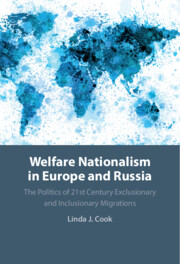 Welfare Nationalism in Europe and Russia
Welfare Nationalism in Europe and Russia Book contents
- Welfare Nationalism in Europe and Russia
- Reviews
- Welfare Nationalism in Europe and Russia
- Copyright page
- Dedication
- Contents
- Figures
- Tables
- Preface
- Acknowledgments
- Note on Terminology
- Abbreviations
- Part I Introduction
- Part II Economic Drivers and Political Mobilizers of Welfare Nationalism and Exclusion in Russia and Europe
- Part III Exclusionary Migrations
- 4 Central Asian Labor Migrants in Russia
- 5 Central and Eastern European Labor Migrants in the EU15
- 6 Asylum Seekers and Labor Migrants from the Middle East and North Africa to Europe
- Part IV Inclusionary Migrations
- References
- Index
4 - Central Asian Labor Migrants in Russia
Authoritarian Politics of Exclusion
from Part III - Exclusionary Migrations
Published online by Cambridge University Press: 14 November 2024
- Welfare Nationalism in Europe and Russia
- Reviews
- Welfare Nationalism in Europe and Russia
- Copyright page
- Dedication
- Contents
- Figures
- Tables
- Preface
- Acknowledgments
- Note on Terminology
- Abbreviations
- Part I Introduction
- Part II Economic Drivers and Political Mobilizers of Welfare Nationalism and Exclusion in Russia and Europe
- Part III Exclusionary Migrations
- 4 Central Asian Labor Migrants in Russia
- 5 Central and Eastern European Labor Migrants in the EU15
- 6 Asylum Seekers and Labor Migrants from the Middle East and North Africa to Europe
- Part IV Inclusionary Migrations
- References
- Index
Summary
Chapter 4 focuses on labor migration from Central Asia to Russia as the first exclusionary migration cycle. Growing migration after 2000 made Russia one of the world’s major migrant-receiving states. The chapter explains why Putin retained a visa-free regime with the much poorer former Soviet states of CA, allowing millions of their citizens free entry to Russia, where most stayed and worked with undocumented status. As the numbers of the ethnically distant Muslim migrants rose, welfare nationalist grievances emerged in the cities and regions where migrants were concentrated. Citing public opinion surveys, speeches by mayors and governors, election and party platforms, and mass media, the chapter shows how politicians framed and used welfare nationalist discourses to placate citizens and scapegoat migrants for declines in popular welfare. It highlights the role of sub-national officials in mobilizing anti-immigrant politics and channeling pressures for exclusionary policies to Putin. These pressures produced legislative and normative changes that progressively excluded migrant families from social sectors and subjected workers to increasing abuses, including deportations and other forms of exclusion. A sub-set of migrants who contributed to Russia’s national security were treated as more deserving.
Keywords
- Type
- Chapter
- Information
- Welfare Nationalism in Europe and RussiaThe Politics of 21st Century Exclusionary and Inclusionary Migrations, pp. 95 - 124Publisher: Cambridge University PressPrint publication year: 2024
